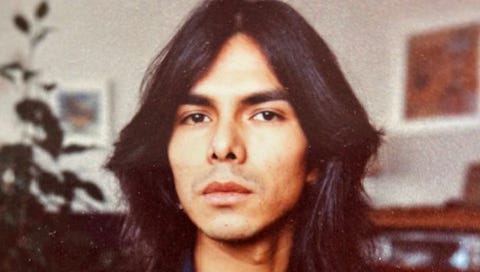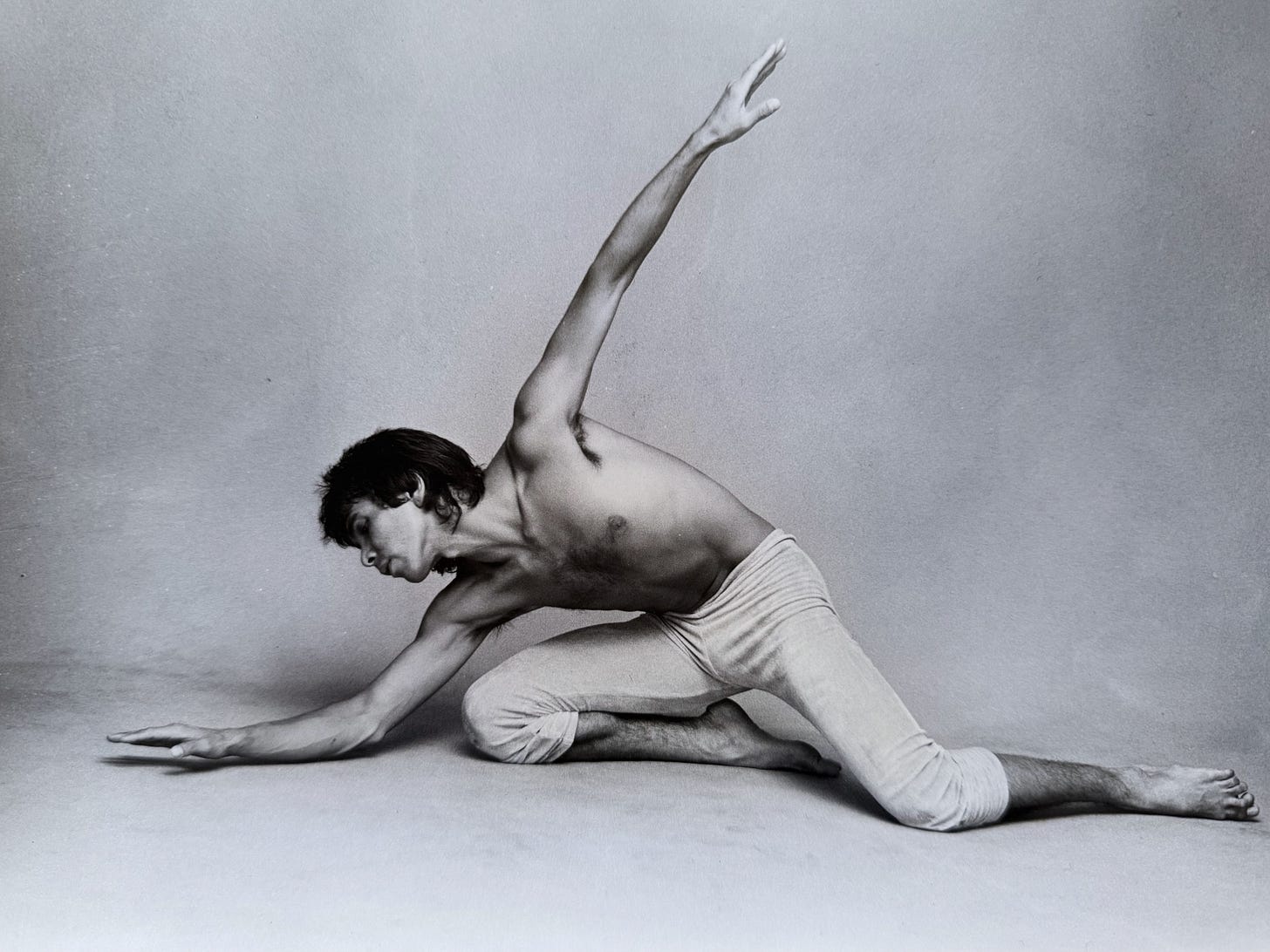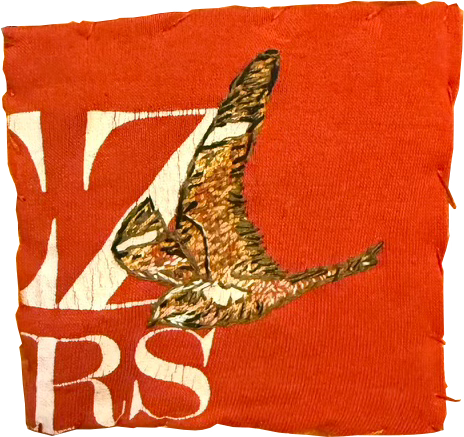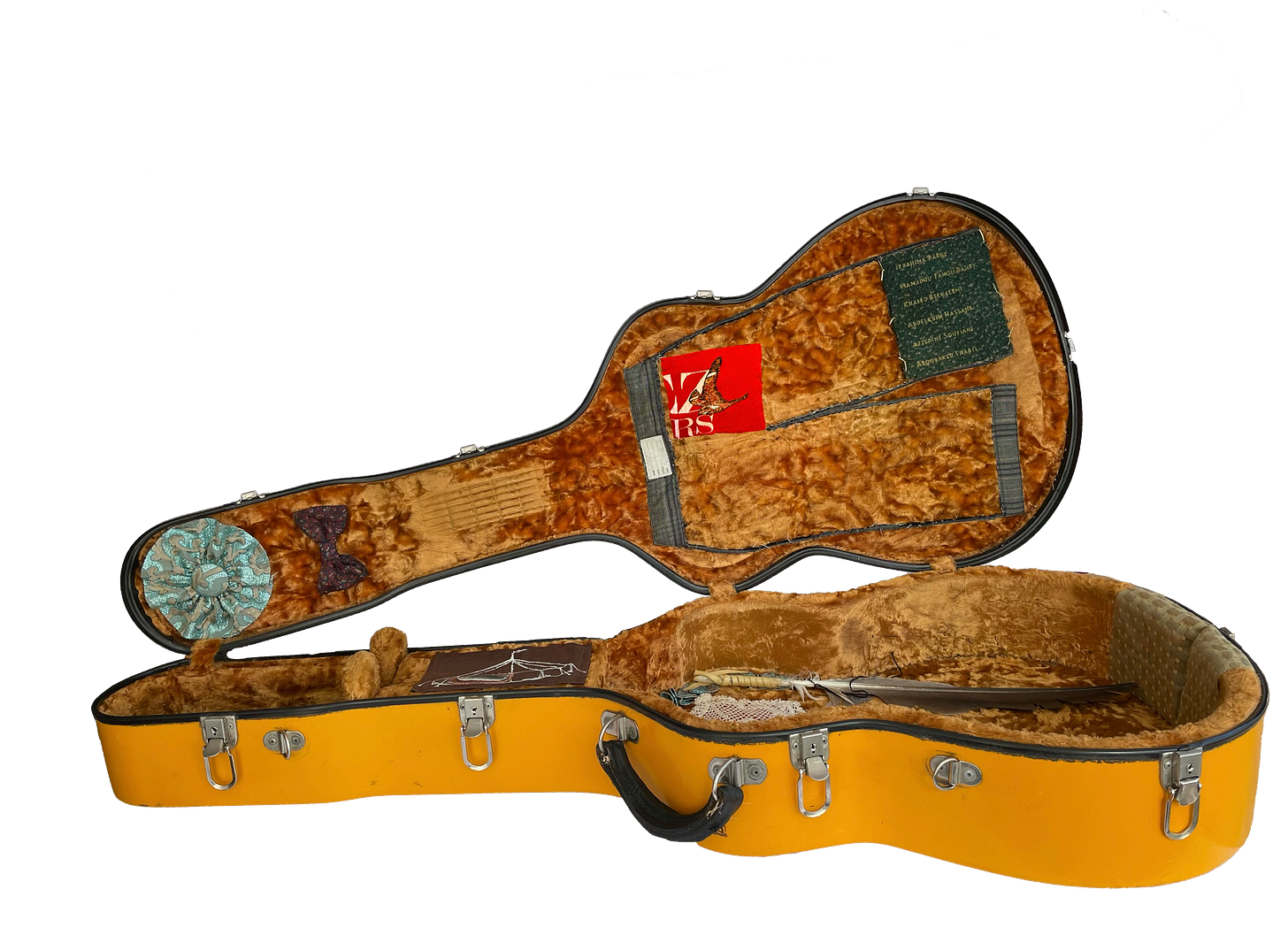Beyond the Six String Nation #38: Elbow and arms and legs and torsos
A new piece joins the collection in our Calton Case
As promised, this is the post/announcement that was pre-empted by yesterday’s preamble. If you didn’t read that one, please go back and check it out because you will see how they’re connected. That one promised to be short(ish). This one, I warn you, is quite a bit longer.
Back in August, I was in Washington D.C., where I had meetings with my friend Mike Orlove at the National Endowment for the Arts, Sabrina Motley at the Smithsonian Folklife Centre and Stephen Elliot at the Canadian Embassy. These meetings were partly about a plan to bring Voyageur to Washington in 2026 and partly to raise the idea of building an American version of the project along slightly different lines. Of course, in August I – like so many other ‘liberals’ – just assumed Kamala Harris would win the upcoming election. An American Guitar would serve as a kind of celebratory reunifying project aimed to launch on America’s 250th birthday on July 4th, 2026.
Kamala Harris did not win the election in November and the whole world is now living with the disastrous consequences of half of Americans living up to journalist H.L. Mencken’s prediction in the Baltimore Evening Sun on July 26, 1920:
As democracy is perfected, the office [of president] represents, more and more closely, the inner soul of the people…On some great and glorious day the plain folks of the land will reach their heart's desire at last, and the White House will be adorned by a downright moron.
More than just a moron, of course: a shallow, preening , brutish, ugly, ignorant, greedy, graceless, and (perhaps worst of all) humourless felon with evil intent and the machinery of power and a cadre of bloviating, cowardly supporters pliantly placed to execute his worst impulses.
Of course, there’s no way in good conscience I could pursue either an American edition of the project or a U.S. visit for Six String Nation in the face of these new circumstances. My communications with Orlove and Motley have gone quiet and I’m honestly not sure whether they expect to retain or even still have their jobs. Certainly, a steady stream of emails from a Canadian proposing a project to celebrate the diverse roots of the evolving story of American music would presumably send off flares to the D.O.G.E. douches.
So yes, with great thanks to Mike Myers and Charlie Angus and others – and feeling the swell of Canadian pride and determination to meet and beat any challenge to our political, territorial and cultural sovereignty, it’s “elbows up” all the way. I’m down for that and glad to be counted part of the resistance however I can help.
But in this exact moment, I have also to announce the addition of a new piece we’ve added to the case and it just so happens that it speaks to the other part of this moment we’re in. We borrow that hockey metaphor and its implied defensive violence to address an existential threat and marshall our collective energy to resist and overcome that threat. But we must also keep our eye on what it is we’re defending – what values lie at the heart of that which we defend.
Put most simply, the motivating idea behind Six String Nation was to create something that would illustrate that we as a nation are greater than the sum of our parts that would itself be greater than the sum of its parts. There is certainly an idealism behind that quest but a kind of practicality too. If you are to make something that “sees” everyone who encounters it, where everyone recognizes part of themselves in it, where it is made apparent that multiple strands of story and perspective and history combine to make a stronger narrative fabric than any individual thread, you are going to have to come to terms with multiple contradictions – some of them trifling, some of them quite stark and existential.
For example, Voyageur contains part of some furniture from the office of Canada’s founding Prime Minister, Sir John A. Macdonald. He established the Conservative Party and founded Canada as a distinct country. He expanded the territory beyond the original Upper and Lower Canadas in what is now Ontario-Quebec-ish to create a tri-coastal country – the second largest in the world. He wheeled-and-dealed to build a railway across some of the world’s most difficult and treacherous terrain – in the midst of a global depression, no less – making it economically feasible to create industries and grow a national economy. He established the North West Mounted Police, which would morph into the current RCMP. He served as Prime Minister for 19 years and made it into the founding mythology of the country with its attendant coins and banknotes and statues and all the rest. He was also an alcoholic, tyrannical personality who was only able to realize his vision by attempting to wipe out the existing indigenous population by force and cultural genocide, clearing the prairie through manufactured starvation, restricting the movement of indigenous people, establishing the residential schools system that would “kill the Indian in the child”, quashing the Northwest Rebellion in what is now Manitoba when it threatened his mission and executing its figurehead - his rival – Louis Riel. He and his ministers took bribes from an American consortium to build his railroad. He imported Chinese labour to build the railroad and treated the workers as subhuman, imposing a head-tax on Chinese immigrants and enacted racist legislation to ensure “the Aryan character of the future of British America”.
Voyageur also includes a major bit of material from Riel (the most real estate, by far, in the guitar) who himself was a person of multiple contradictions but paid the ultimate price for his legitimate opposition to Macdonald.
It also includes stone from the monument to Kitchi-Manito Waya (aka Almighty Voice) from the One Arrow Willow Cree Reserve, whose community was one of those restricted from moving as punishment for participating in the Northwest Rebellion and subject to a campaign of forced starvation, during which Kitchi-Manito Waya slaughtered a steer seized by the government from his father in order to feed his family, was imprisoned and threatened with execution, and subsequently escaped, evading capture for 19 months before being murdered by the aforementioned NWMP.
It also includes part of the original gate to Fan Tan Alley in Victoria B.C. – a ghetto for the single, male Chinese workers imported to Canada to build the railroad and do other service jobs. With no ability to bring family, subject to extraordinary workplace dangers and general abuse, many of the workers in this area resorted to opium use as a salve to despair and were subject to frequent raids by police. The gates functioned as a kind of early warning system for the raids. It is now a twee touristic strip of charming boutiques and the recognized home of Canada’s first “Chinatown”. A guitar is built to contain tensions. It’s how an acoustic instrument works. Solid wood is bent around forms to create its shape and contain and project its vibrations. The strings alone pull 160lbs of pressure across the bridge constantly in order for us to hear those sweet notes ring out.
So bullying and greed and tyranny are not unique to Donald Trump or this historical moment. These tactics are always adjacent to power (and almost always part of its eventual downfall). We have our own sordid history with all of that – and much that continues to this day. Here in Toronto, we had a kind of preview of the led-by-morons political climate in the mayoralty of Rob Ford. As with Trump, his tenure was primarily defined by chaos. And, as with Trump, his fame grew not in spite of his erratic and anti-social behaviour but because of it. Certainly the Toronto media hung on every word and every scandalously disqualifying offence but soon he became the object of fascination on Kimmel and Colbert because… who can look away from such a shitshow?
Again like Trump, Ford was prone to casual bigotry, self-dealing, favour-bestowing, committee stacking and public intimidation. Who can forget the site of Rob and his brother Doug (now Ontario’s premier) and pathetic attack dog, Councillor Giorgio Mammoliti, confronting legitimate opposition in the public gallery at City Hall by shouting down citizens, name-calling and recording people on their smartphones – real classy Mussolini/gangster-type stuff. For the inauguration ceremony at the first meeting of the new council after his election, Ford invited the blowhard hockey commentator Don Cherry to put the chain of office on him. In his opening remarks, Cherry declaimed "Put that in your pipe you left-wing kooks" and, explaining the pink suit he was wearing, "I'm wearing pinko for all the pinkos out there that ride bicycles and everything, I thought I'd get it in." Bullying. Plain and simple schoolyard bullying draped with the aura of political officialdom and power.
But here’s the thing: I have a pair of black-on-grey plaid pants belonging to Don Cherry sewn into the lid of the case too (I had asked for one of his colourful jackets, of course, but he demurred). Still, he is part of the culture. There’s a whole story behind that inclusion that is due for a separate post, which I’ll do another time. For now, I’ll just say that after Cherry’s bigoted comments during a segment of “Coaches Corner” on November 9, 2019’s Hockey Night in Canada broadcast, I was tempted to just take the pants out of the case altogether. Why was I dedicating such a large amount of visible real estate to such a person – especially when he offered so little of himself in the donation. Black on grey? Really? But I didn’t want to act too rashly and I was concerned about the whole notion of “cancelling” people. If I got rid of Cherry’s pants, would I reach into Voyageur and extract the structural supports contributed by Sir John A.? I took the question to a group of students at Unionville Montessori School assembled for me by principal Dave Treherne – grades 8-10, mostly girls, diverse backgrounds. After talking through the issue, they said, “Don’t remove all of the pants. It’s because those pants are there that we are now having a conversation about racism and Islamophobia. It maybe doesn’t need to be so much material but leave some of it”. It was extraordinarily thoughtful and wise counsel. So that’s what we did. We left the waistband with the signature tailor’s tag in place. Without access to the machinery required to remove and re-install the case lining, textile artist Holly Boileau had to pick around the stitching Al Williams and Trudy Graham of Calton Cases Canada had used to originally affix the pants – what remains is a neat outline of the pants-shape and the cuffs as well as the waistband. That left a lot of real estate in the case lid available for future contributions. And I vowed at that point that I would gradually fill that space with the colours Cherry withheld from us using materials drawn from the kinds of communities and individuals Cherry and his ilk would so casually mock and bully as part of their “brand”. The first piece that went in was a swatch of green carpet from the CCIQ Mosque in St. Foy, Quebec, where a gunman addled by Donald Trump speeches and a steady diet of Fox News and Ben Shapiro tweets had killed six men and injured nineteen others gathered for evening prayers. The green rectangle is emblazoned with the names of the dead in a kind of gold leaf.
Holly has now completed the addition of a second piece of material to the recolouration of Cherry’s pants and that – FINALLY – is the real subject of today’s post!
Never mind the challenges that still exist, in 1970s Canada it would have been hard enough to be from the northwest corner of Manitoba. It would have been hard enough to be indigenous. It would have been hard enough to be gay. It would have been hard enough to try to live as an artist. Put all of those attributes together and you can imagine a very tough row to hoe.
But in 1979, budding playwright Tomson Highway, back from his studies at the University of Western Ontario, took his little brother René from their home in Brochet down to Winnipeg to see a performance by the Royal Winnipeg Ballet. And from that moment, René Highway knew the path he had to follow. The first step in that path was to follow his brother back to Toronto where Tomson was establishing himself as a writer, composer and artistic director. René studied with the Toronto Dance Theatre and the Native Canadian Centre and immersed himself in indigenous dance traditions with the Tuukaq Teatret, an Inuit-led dance company located in Lemvig on the northwest coast of Denmark. He returned to Toronto to become a member of the TDT company, performing in Toronto, New York, Europe and across Canada.
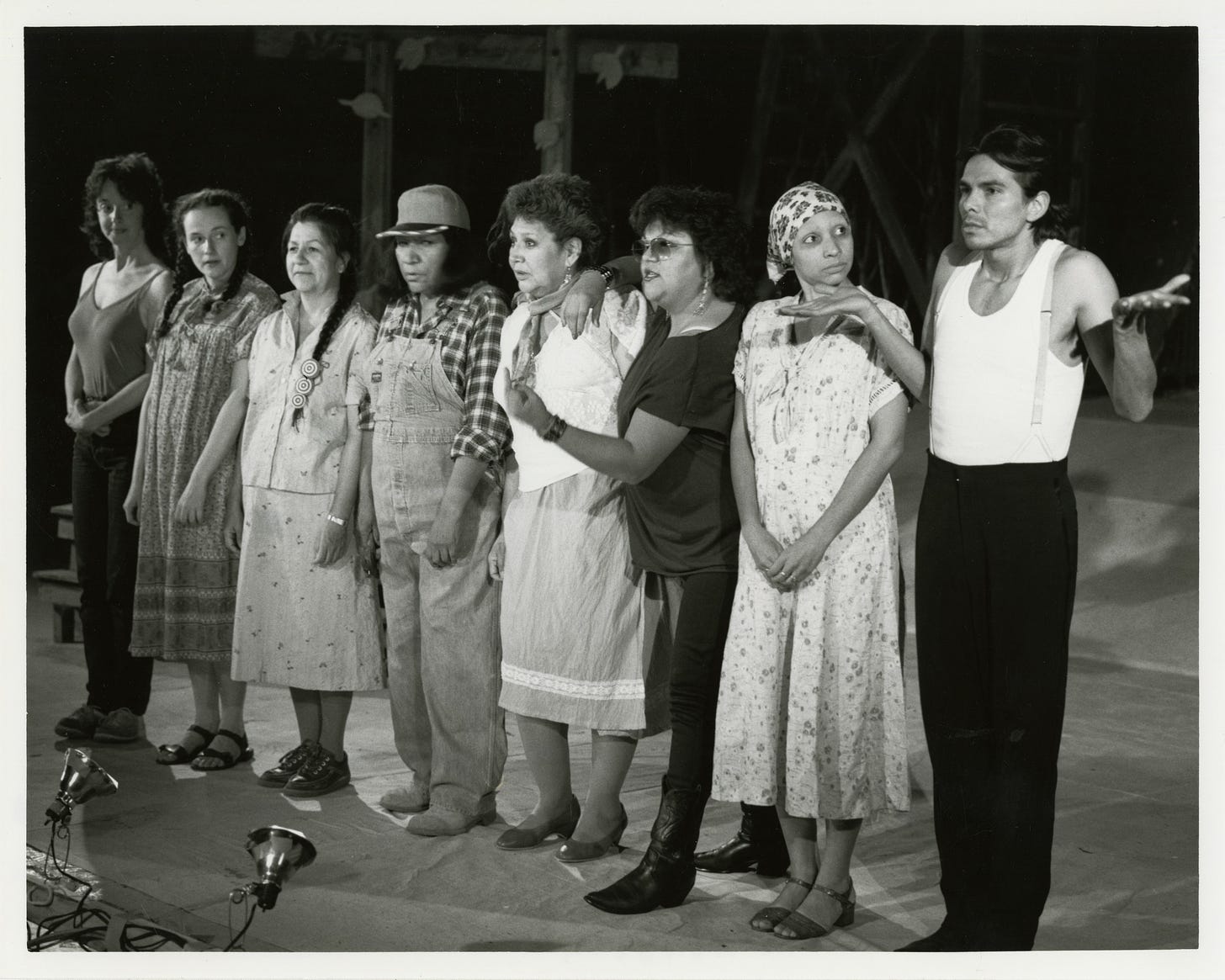
In 1986, Tomson published his play The Rez Sisters and assumed the role of Artistic Director of Toronto’s Native Earth Performing Arts. Tomson and René collaborated on the creation of the character of Nanabush – a pivotal “trickster” character in the play rooted in Cree and other indigenous storytelling. The company mounted the first production of the play, which played to much acclaim and multiple awards for productions across Canada. In 1988, The Rez Sisters was invited to the Edinburgh International Festival in Scotland, where it was a smash success. For the Festival, Native Earth had made cast and crew T-shirts. This is the one given to and worn by René:
One of the forms taken by the Nanabush trickster in The Rez Sisters is that of a nighthawk and in searching for images of the bird, textile artist Holly Boileau was struck by the echoes of a performance shot of René with the Toronto Dance Theatre:
Using just enough of the T-shirt to make clear its origins and incorporating the image of the nighthawk, Holly created this beautiful patch to join the other pieces in the case and the next to begin to fill in the void left by Don Cherry’s grey.
Here’s how it looks in the case:
You’ll notice there are some gaps around the application of the swatch. Renés brother Tomson has offered a parka worn by his little brother around the age of 3. We will pick up that material in Ottawa hopefully later this month and it will be added as a kind of border around the T-shirt material (kind of like a parka hood) later in the year.
René Highway died of HIV/AIDS complications on October 19th, 1990 – just shy of his 36th birthday. The contribution of his T-shirt was made by his life-partner, the singer, entertainment industry coach and Queen St. icon Micah Barnes. This beautiful little two-spirited kid from an unincorporated community in northwestern Manitoba on the northern shore of Reindeer Lake near the Saskatchewan border travelled far and accomplished much in his short life. Now I’m hoping that he will be just one more of the many ways in which some of the people who encounter Voyageur and the Six String Nation project will see one or more aspects of themselves reflected in it.
There’s one more thing I have to say about René, who I never met in person, but who I’ve come to know through conversations with Micah and Tomson…
Back near the top of this post, I described Donald Trump as a shallow, preening , brutish, ugly, ignorant, greedy, graceless, and (perhaps worst of all) humourless felon. He will forever be remembered as President of the United States, a reality television star, a sexual assaulter, and a con-man who plastered his name on everything he could think of, no matter how putrid or junky or plain illegal – all to assuage a gluttonous ego. René Highway, as an artist and as a human being embodied the antithesis of all those descriptors: he was deep, proud, refined, beautiful, curious, creative, generous, graceful and full of humour. I’m proud to be associated with him in some small way through this project.


